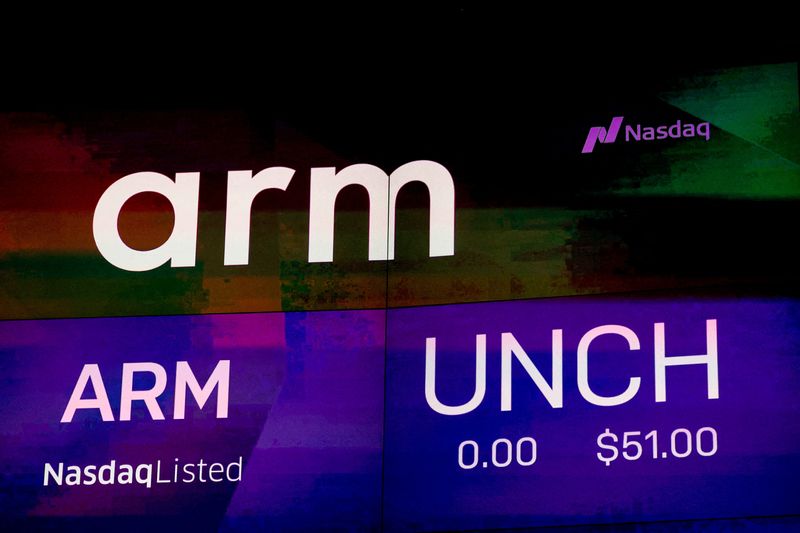By Max A. Cherney and Stephen Nellis
(Reuters) – Arm Holdings on Wednesday gave a full-year revenue forecast that fell short of expectations among investors who pushed up the chip designer’s shares last September after its listing in the stock market due to optimism around AI.
Arm shares fell about 7% in extended trading after the report was released.
Arm’s March quarter results largely beat expectations, but its full-year guidance underscores uncertainty over the pace of development in artificial intelligence and whether investors have grown AI-related stocks more than their growth rates warrant.
“The decline is due to the outlook. Arm is rated for outperformance, not for this,” said Kinngai Chan, an analyst at Summit Insights.
Shares of other AI chipmakers fell after Arm’s report, with Nvidia and Advanced Micro Devices each down about 0.5%.
For the current fiscal first quarter, Arm forecasts revenue in the range of $875 million to $925 million, with a midpoint of $900 million, compared to an average analyst estimate of $857.5 million, according to LSEG data .
The British chip designer also said it expects annual revenue between $3.8 billion and $4.1 billion, with a midpoint of $3.95 billion. That compares to a consensus estimate of $3.99 billion.
Arm expects full-year earnings per share of between $1.45 and $1.65, compared with analysts’ average estimate of $1.54.
“I wanted to make sure we set a goal that was tied to what we have a lot of confidence in and what we can achieve,” Arm Chief Financial Officer Jason Child told Reuters in an interview. The timing of some of the company’s licensing deals, he added, can be “difficult to pin down,” so the company is publishing a range as a guide.
Bets that Arm would benefit from a boom in AI computing have doubled the chipmaker’s stock price since its IPO last September, giving it a market value of about $110 billion.
Its shares have recently traded at nearly 70 times expected earnings, compared to chipmaker Nvidia’s 35 times earnings, according to LSEG data.
Arm’s fourth-quarter revenue rose 47% to $928 million, compared with analysts’ estimates of $875.6 million.
Arm generates revenue through licensing fees for its semiconductor designs and receives a royalty for each chip sold using its technology.
It closed four major licensing deals during the quarter, which is why that segment grew significantly, Child said. The royalties activity benefited from a new Arm design which imposes a higher rate and now represents 20% of the segment, growing by 5 percentage points.
Arm’s designs power almost every smartphone in the world, and the company has tried to make headway in data centers and other markets. Chips with Arm technology generate $200 billion in revenue annually for the many chipmakers that sell them, according to a TD Cowen study.
The company’s licensing business grew 60% to $414 million in the fourth quarter compared to the same period last year, and the royalty segment jumped 37% to $514 million.
Arm reported fourth-quarter earnings of 36 cents per share, adjusted for, among other things, stock-based compensation.
That beats the consensus estimate of 30 cents per share.
Although Arm’s designs are adjacent to the chips that power AI applications, the company’s revenue and profits have not benefited from AI to the same extent as Nvidia’s.
(Reporting by Max A. Cherney and Stephen Nellis in San Francisco, additional reporting by Arsheeya Bajwa and Pushkala Aripaka in Bengaluru, and Noel Randewich in Oakland, California; Editing by Matthew Lewis)








